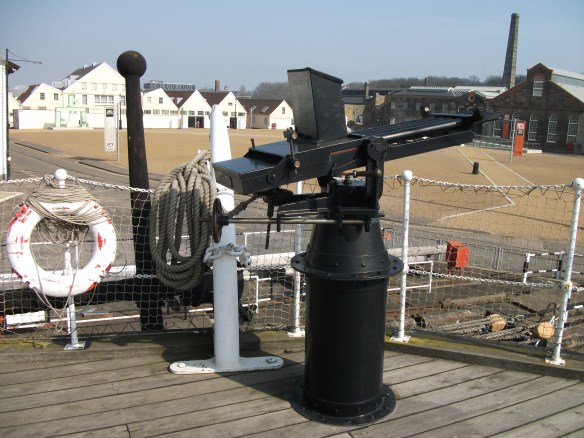The Nordenfelt machine-gun was designed by H Heldge Palmcrantz. However, Thorsten Nordenfelt, who had provided the financial and marketing assistance, demanded that the gun bear his name. It did, but this did not help sales of the ‘organ gun’ and even though the team built versions in a wide range of calibres they came too late in a century that had seen dramatic advances in artillery and small arms. In the 1890s Nordenfelt teamed up with Hiram Maxim the doyen of automatic weapons design, the intention being to market larger-calibre guns. The partnership was, however, short-lived and unproductive and was wound up in 1897.
At the same time that U. S. inventors were striving to produce a reliable fast-shooting single-barreled gun, European engineers continued to improve volley-fire weapons. The Nordenfelt gun was invented by British engineer Helge Palmcrantz and financed by Thorsten Nordenfelt, a Swedish banker in London who put up the money and whose name was therefore attached to the gun. The Nordenfelt could be described as a mechanized battery gun that was essentially a hybrid of the Mitrailleuse and the Gatling gun. It was another multiple-barreled gun, but the barrels, which varied from two to 12, were mounted laterally side-by-side. In the three-barreled version, 27 brass cartridges were mounted on a wooden strip that could feed the gun at a rate of 350 shots per minute. Regardless of the number of barrels, the loading mechanism was essentially the same. An overhead hopper magazine carried as many columns of cartridges as barrels and delivered them into a carrier block operated by a hand lever. This lever was pushed forward to take the carrier block forward until the cartridges were lined up in their chambers. A breech block then moved forward to force the cartridges home, and an action block containing the firing pins moved in behind the breech block and lined up with the caps of the cartridges. At the end of the forward stroke of the handle, the firing pins were tripped, which fired the rounds. On the return stroke of the lever, the action block moved away, and the carrier block pulled clear and ejected the empty cases, moving back to pick up a fresh load of cartridges. The greatest advantage of this gun was that it weighed only 13 pounds.
The weapon was first shown to a committee of Swedish and Norwegian military personnel in 1870-1877. This committee established a set of criteria for subsequent tests of the Nordenfelt that would serve as a model for the development and adoption of the machine gun, not only in Sweden and Norway but also throughout Europe and in the United States. These requirements would serve as design parameters for additional improvements to the machine-gun concept. They included:
- Rapidity of fire (which should reach the rate of 300 or 400 rounds per minute).
- The mechanism should not be easily put out of order, even if the rapidity of fire occasionally exceeded the normal standard.
- The gun, with a considerable number of rounds (say, 4,000), should be capable of draught by two horses.
- The piece should be readily separated, if necessary, from its carriage and be capable of conveyance by hand should the place desired be inaccessible to horses. No special tools should be required for this, save for a powerful screwdriver or hammer.
- It should be furnished with an automatic apparatus for giving and regulating the horizontal spread of bullets, at various angles, and be capable of easy elevation throughout a sufficient height.
- The ammunition used should, if possible, be interchangeable with that of the infantry.
- Two men should be capable of performing all the duties of the piece when under fire.
- Some sort of rangefinder should always be employed with the weapon.
The Nordenfelt passed the test with flying colors. The Swedish-Norwegian Committee reported that the gun was capable of firing 450 rounds per minute and was very reliable, even under damp conditions and with less-than-thorough cleaning between firings. Despite the advantages, military authorities in most European armies still looked at machine guns with suspicion and were less than interested in the Nordenfelt gun for ground combat.
Specifications
CALIBER: .45
WEIGHT: 372 lbs (168.74 kg) with shields, hoppers, cone, and empty distributor
LENGTH: 46″ (1168mm)
RATE OF FIRE: 600 rpm
FEED: 50-round hopper; 50-round distribution box
MUZZLE VELOCITY: unknown
ORIGINAL COUNTRY OF MANUFACTURE: Great Britain
FIRST PRODUCED: 1884
NOTES: The Nordenfelt machine gun is a battery gun invented by a Swede, Helge Palmcrantz, and was named for the Swedish banker who set up a factory in England to build Palmcrantz’s design. The Nordenfelt could be described as a mechanized battery gun that was essentially a hybrid of the Mitrailleuse and the Gatling. There were versions of this design that had from two to 12 barrels mounted laterally on a pedestal or a carriage. The Nordenfelt gun saw service in navies in Europe, as well as in the United States.
